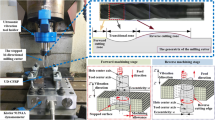Abstract
An innovative machining process, i.e., tilted helical milling (THM), was proposed previously by the authors for high-quality hole drilling of CFRP as an alternative technique to conventional helical milling (CHM). To further develop the THM technique, hole surface finish with THM is analyzed and compared to that finished with CHM in this article. Theoretical analysis results show that a large amount of fiber bending and fiber-matrix debinding in CHM will occur in the hole surface when instantaneous fiber cutting angle α lies in the range of 90° to 180° due to the tool pushing. This phenomenon can be mitigated in THM owing to a downward cutting force component along the hole axis, which makes fibers fracture easily. The theoretical analysis results are confirmed by CT scans and SEM results of surface morphology of holes, indicating THM is useful for obtaining high-quality hole surface finish. In addition, compared with CHM, damage generation, such as entrance split and exit delamination of the hole, can be restrained with THM technique.
Similar content being viewed by others
References
Wang HJ, Sun J, Zhang DD, Guo K, Li JF (2016) The effect of cutting temperature in milling of carbon fiber reinforced polymer composites. Compos Part A-Appl Sci Manuf 91:380–387
Cheng H, Zhang KF, Wang N, Luo B, Meng QX (2017) A novel six-state cutting force model for drilling-countersinking machining process of CFRP-Al stacks. Int J Adv Manuf Technol 89:2063–2076
Zitoune R, Krishnaraj V, Collombet F (2010) Study of drilling of composite material and aluminium stack. Compos Struct 92(5):1246–1255
Wei JC, Jiao GQ, Jia PR, Huang T (2013) The effect of interference fit size on the fatigue life of bolted joints in composite laminates. Compos Part B-Eng 53:62–68
Alberdi A, Artaza T, Suarez A, Rivero A, Girot F (2016) An experimental study on abrasive waterjet cutting of CFRP/Ti6Al4V stacks for drilling operations. Int J Adv Manuf Technol 86:691–704
Khashaba UA (2004) Delamination in drilling GFR-thermoset composites. Compos Struct 63(3–4):313–327
Liu DF, Tang YJ, Cong WL (2012) A review of mechanical drilling for composite laminates. Compos Struct 94(4):1265–1279
Pereira RBD, Brandao LC, Paivab AP, Ferreira JR, Davim JP (2017) A review of helical milling process. Int J Mach Tools Manuf 120:27–48
Wang HY, Qin XD, Ren CZ, Wang Q (2011) Prediction of cutting forces in helical milling process. Int J Adv Manuf Technol 58:849–859
Li ZQ, Liu Q (2013) Surface topography and roughness in hole-making by helical milling. Int J Adv Manuf Technol 66:1415–1425
Liu J, Chen G, Ji CH (2014) An investigation of workpiece temperature variation of helical milling for carbon fiber reinforced plastics (CFRP). Int J Mach Tools Manuf 86:89–103
Iyer R, Koshy P, Ng E (2007) Helical milling: an enabling technology for hard machining precision holes in AISI D2 tool steel. Int J Mach Tools Manuf 47(2):205–210
Denkena B, Boehnke D, Dege JH (2008) Helical milling of CFRP-titanium layer compounds. CIRP J Manuf Sci Technol 1(2):64–69
Eguti CCA, Trabasso LG (2014) Design of a robotic orbital driller for assembling aircraft structures. Mechatronics 24(5):533–545
Shan YC, He N, Li L, Zhao W, Qin XJ (2011) Orbital milling hole of aerospace Al-alloy with big pitch. Trans Tian** Univ 17(5):329–335
Wang HY, Qin XD, Li H, Ren CZ (2013) Analysis of cutting forces in helical milling of carbon fiber-reinforced plastic. P I Mech Eng B-J Eng 227:62–74
Wu YB, Wang Q, Nomura M (2016) Proposal of tilt helical milling method for hole creation of carbon fiber reinforced plastic (CFRP). Adv Mater Res 1136:190–195
Wang Q, Wu YB, Bitou T, Nomura M, Fujii T (2018) Proposal of a tilted helical milling technique for high quality hole drilling of CFRP: kinetic analysis of hole formation and material removal. Int J Adv Manuf Technol 94(9–12):4221–4235
Wang HY, Qin XD (2016) A mechanistic model for cutting force in helical milling of carbon fiber-reinforced polymers. Int J Adv Manuf Technol 82(9):1485–1494
Karpat Y, Bahtiyar O, Deger B (2012) Mechanistic force modeling for milling of unidirectional carbon fiber reinforced polymer laminates. Int J Mach Tools Manuf 56:79–93
Wang XM, Zhang LC (2003) An experimental investigation into the orthogonal cutting of unidirectional fiber reinforced plastics. Int J Mach Tools Manuf 43(10):1015–1022
Xu WX, Zhang LC (2016) Mechanics of fiber deformation and fracture in vibration-assisted cutting of unidirectional fiber-reinforced polymer composites. Int J Mach Tools Manuf 103:40–52
Gupta V (2013) An introduction to mechanics of materials. Alpha Science Intl, Oxford, pp 710–711
Acknowledgements
Deepest thanks is given to Mr. Junfei Huang (Shimadzu (China) Co., LTD. Shenzhen Branch) for his help on the experimental works of CT-scans.
Funding
The authors received financial support from the National Natural Science Foundation of China (Grant nos. 51405218, 51505444) and Shenzhen knowledge innovation plan (Grant no. J20180097).
Author information
Authors and Affiliations
Corresponding authors
Rights and permissions
About this article
Cite this article
Wang, Q., Wu, Y., Li, Y. et al. Proposal of a tilted helical milling technique for high-quality hole drilling of CFRP: analysis of hole surface finish. Int J Adv Manuf Technol 101, 1041–1049 (2019). https://doi.org/10.1007/s00170-018-2995-5
Received:
Accepted:
Published:
Issue Date:
DOI: https://doi.org/10.1007/s00170-018-2995-5




